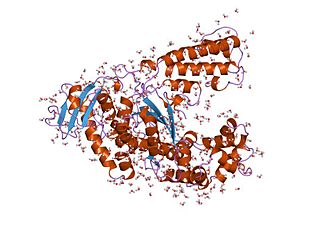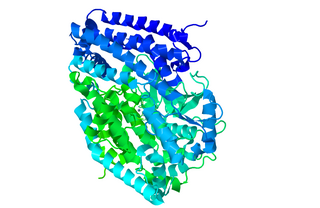Related Research Articles

Thermus aquaticus is a species of bacteria that can tolerate high temperatures, one of several thermophilic bacteria that belong to the Deinococcota phylum. It is the source of the heat-resistant enzyme Taq DNA polymerase, one of the most important enzymes in molecular biology because of its use in the polymerase chain reaction (PCR) DNA amplification technique.

Taq polymerase is a thermostable DNA polymerase I named after the thermophilic eubacterial microorganism Thermus aquaticus, from which it was originally isolated by Chien et al. in 1976. Its name is often abbreviated to Taq or Taq pol. It is frequently used in the polymerase chain reaction (PCR), a method for greatly amplifying the quantity of short segments of DNA.

Pinosylvin is an organic compound with the formula C6H5CH=CHC6H3(OH)2. A white solid, it is related to trans-stilbene, but with two hydroxy groups on one of the phenyl substituents. It is very soluble in many organic solvents, such as acetone.
Alcohol dehydrogenase (quinone) (EC 1.1.5.5, type III ADH, membrane associated quinohaemoprotein alcohol dehydrogenase) is an enzyme with systematic name alcohol:quinone oxidoreductase. This enzyme catalyses the following chemical reaction
Cyclic alcohol dehydrogenase (quinone) (EC 1.1.5.7, cyclic alcohol dehydrogenase, MCAD) is an enzyme with systematic name cyclic alcohol:quinone oxidoreductase. This enzyme catalyses the following chemical reaction
Quinate dehydrogenase (quinone) (EC 1.1.5.8, NAD(P)+-independent quinate dehydrogenase, quinate:pyrroloquinoline-quinone 5-oxidoreductase) is an enzyme with systematic name quinate:quinol 3-oxidoreductase. This enzyme catalyses the following chemical reaction
Acetyl-S-ACP:malonate ACP transferase is an enzyme with systematic name acetyl-(acyl-carrier-protein):malonate S-(acyl-carrier-protein)transferase. This enzyme catalyses the following chemical reaction
Chitosanase is an enzyme with systematic name chitosan N-acetylglucosaminohydrolase. This enzyme catalyses the following chemical reaction
4-alpha-D-{(1->4)-alpha-D-glucano}trehalose trehalohydrolase is an enzyme with systematic name 4-alpha-D-( -alpha-D-glucano)trehalose glucanohydrolase (trehalose-producing). This enzyme catalyses the following chemical reaction

Peptidyl-dipeptidase Dcp (EC 3.4.15.5, dipeptidyl carboxypeptidase (Dcp), dipeptidyl carboxypeptidase) is a metalloenzyme found in the cytoplasm of bacterium E. Coli responsible for the C-terminal cleavage of a variety of dipeptides and unprotected larger peptide chains. The enzyme does not hydrolyze bonds in which P1' is Proline, or both P1 and P1' are Glycine. Dcp consists of 680 amino acid residues that form into a single active monomer which aids in the intracellular degradation of peptides. Dcp coordinates to divalent zinc which sits in the pocket of the active site and is composed of four subsites: S1’, S1, S2, and S3, each subsite attracts certain amino acids at a specific position on the substrate enhancing the selectivity of the enzyme. The four subsites detect and bind different amino acid types on the substrate peptide in the P1 and P2 positions. Some metallic divalent cations such as Ni+2, Cu+2, and Zn+2 inhibit the function of the enzyme around 90%, whereas other cations such as Mn+2, Ca+2, Mg+2, and Co+2 have slight catalyzing properties, and increase the function by around 20%. Basic amino acids such as Arginine bind preferably at the S1 site, the S2 site sits deeper in the enzyme therefore is restricted to bind hydrophobic amino acids with phenylalanine in the P2 position. Dcp is divided into two subdomains (I, and II), which are the two sides of the clam shell-like structure and has a deep inner cavity where a pair of histidine residues bind to the catalytic zinc ion in the active site. Peptidyl-Dipeptidase Dcp is classified like Angiotensin-I converting enzyme (ACE) which is also a carboxypeptidase involved in blood pressure regulation, but due to structural differences and peptidase activity between these two enzymes they had to be examined separately. ACE has endopeptidase activity, whereas Dcp strictly has exopeptidase activity based on its cytoplasmic location and therefore their mechanisms of action are differentiated. Another difference between these enzymes is that the activity of Peptidyl-Dipeptidase Dcp is not enhanced in the presence of chloride anions, whereas chloride enhances ACE activity.
Aqualysin 1 is an enzyme. This enzyme catalyses the following chemical reaction
Chitin disaccharide deacetylase (EC 3.5.1.105, chitobiose amidohydolase, COD, chitin oligosaccharide deacetylase, chitin oligosaccharide amidohydolase) is an enzyme with systematic name 2-(acetylamino)-4-O-(2-(acetylamino)-2-deoxy-beta-D-glucopyranosyl)-2-deoxy-D-glucopyranose acetylhydrolase. This enzyme catalyses the following chemical reaction
Streptothricin hydrolase (EC 3.5.2.19, sttH (gene)) is an enzyme with systematic name streptothricin-F hydrolase. This enzyme catalyses the following chemical reaction
Indole-3-carboxylate decarboxylase (EC 4.1.1.92) is an enzyme with systematic name indole-3-carboxylate carboxy-lyase. This enzyme catalyses the following chemical reaction
ent-Sandaracopimaradiene synthase is an enzyme with systematic name ent-copalyl-diphosphate diphosphate-lyase [ent-sandaracopimara-8(14),15-diene-forming]. This enzyme catalyses the following chemical reaction
ent-Pimara-8(14),15-diene synthase is an enzyme with systematic name ent-copalyl-diphosphate diphosphate-lyase [ent-pimara-8(14),15-diene-forming]. This enzyme catalyses the following chemical reaction
Aphidicolan-16β-ol synthase (EC 4.2.3.42, PbACS) is an enzyme with systematic name 9α-copalyl-diphosphate diphosphate-lyase (aphidicolan-16β-ol-forming). This enzyme catalyses the following chemical reaction
2-deoxy-scyllo-Inosose synthase is an enzyme with systematic name D-glucose-6-phosphate phosphate-lyase (2-deoxy-scyllo-inosose-forming). This enzyme catalyses the following chemical reaction
(1→4)-α-D-Glucan 1-α-D-glucosylmutase is an enzyme with systematic name (1->4)-alpha-D-glucan 1-alpha-D-glucosylmutase. This enzyme catalyses the following chemical reaction
Prosolanapyrone-III cycloisomerase is an enzyme with systematic name prosolanapyrone-III:(-)-solanapyrone A isomerase. This enzyme catalyses the following chemical reaction
References
- ↑ Lee SH, Minagawa E, Taguchi H, Matsuzawa H, Ohta T, Kaminogawa S, Yamauchi K (November 1992). "Purification and characterization of a thermostable carboxypeptidase (carboxypeptidase Taq) from Thermus aquaticus YT-1". Bioscience, Biotechnology, and Biochemistry. 56 (11): 1839–44. doi:10.1271/bbb.56.1839. PMID 1369078.
- ↑ Lee SH, Taguchi H, Yoshimura E, Minagawa E, Kaminogawa S, Ohta T, Matsuzawa H (August 1994). "Carboxypeptidase Taq, a thermostable zinc enzyme, from Thermus aquaticus YT-1: molecular cloning, sequencing, and expression of the encoding gene in Escherichia coli". Bioscience, Biotechnology, and Biochemistry. 58 (8): 1490–5. doi:10.1271/bbb.58.1490. PMID 7765282.